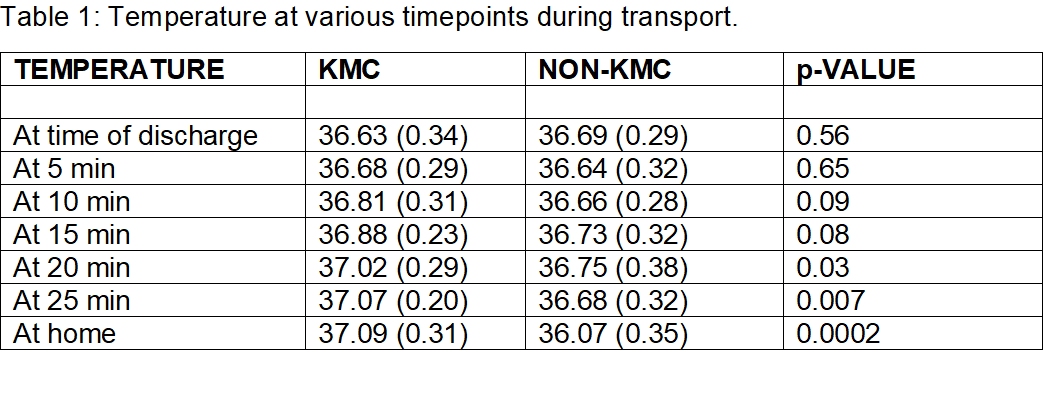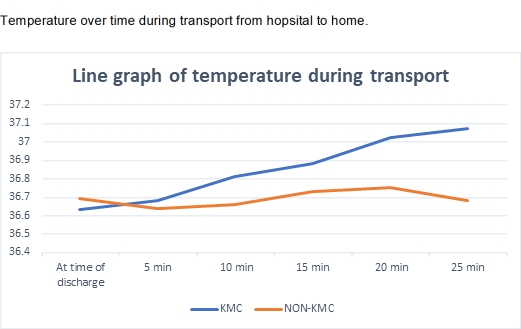Back
Neonatal Clinical Trials
Category: Abstract Submission
Neonatal Clinical Trials I
428 - Randomized Control Trial of Kangaroo Mother Care Transport from Hospital to Home in Low Birth Weight Neonates.
Saturday, April 23, 2022
3:30 PM – 6:00 PM US MT
Poster Number: 428
VEDANT Y. POPAT, BHAIKAKA UNIVERSITY, RAJKOT, Gujarat, India; Somashekhar M. Nimbalkar, Bhaikaka University, Karamsad, Gujarat, India; Dipen V. Patel, Bhiakaka University, Karamsad, Gujarat, India; Archana S. Nimbalkar, Bhaikaka University, Karamsad, Gujarat, India; MAYUR SHINDE, BHAIKAKA UNIVERSITY, Anand, Gujarat, India; Reshma Pujara, Shree Krishna Hospital, Pramukhswami Medical College, Karamsad, Karamsad, Anand, Gujarat, India; Ajay G. Phatak, Bhaikaka University, Karamsad, Anand, Gujarat, India

Somashekhar M. Nimbalkar, n/a
Professor of Neonatology
Bhaikaka University
Karamsad, Gujarat, India
Presenting Author(s)
Background: KMC reduces neonatal and maternal mortality and morbidity, helps in proper weight gain, achieves exclusive breastfeeding, prevents infections, reduces stress, and enhances stabilization, brain development, and bonding between the newborn and the mother. Kangaroo mother care has been used to prevent hypothermia, which makes it an ideal position in which neonates can be transported. Very few studies are available which had studied this aspect of KMC transport.
Objective: To determine the effectiveness of kangaroo mother care for the primary outcome of hypothermia prevention during transport from hospital to home for low birth weight neonates.
Design/Methods: Randomized control trial. All the neonates had received KMC in the hospital and were aware of the process of KMC. The first group (KMC group) received Kangaroo Mother Care by the mother during transportation. The second group (Non-KMC) did not receive KMC during transportation. Patients were transported in an ambulance called “KHILKHILAHAT,” where all patients were transported by a non-AC car with minimal facilities. The investigators accompanied the patient home. The body temperature was recorded by every 5 minutes during transport till they reached their respective home. ‘KHILKHILAHAT’ transported the patients to near distances up to 30 km. The episodes of hypothermia were recorded. The research received ethics approval and was registered on CTRI website of India
Results: The mean (SD) gestational age (in weeks) at admission and discharge of the neonates was 35.7 (2.47) weeks and 37.3 (2.15) weeks, respectively. The mean (SD) weight (in kg) at admission and discharge of the neonates was 2.01 (0.39) kg and 2.08 (0.29) kg, respectively. Independent sample t-test revealed that there is a significant difference in temperature between the two groups that were noted after 15 minutes, as shown in Table 1. The mean difference in temperature readings at home to at the time of discharge was higher in KMC [0.45(0.24)] compared to non-KMC [0.01(0.28)], which is statistically significant in both groups [p < 0.001].
Conclusion(s): We show that the temperature readings were maintained in the KMC Group, whereas the NON-KMC Group showed a fall in temperature readings at the end of the transport when the duration was more than 20 minutes. When RCTs are designed for further studies, a minimum distance of 15-20 minutes needs to be considered in tropical climate settings.
Table 1: Temperature at various timepoints during transport. Till about 15 minutes there is no difference between the groups but begins to increase beyond that.
Till about 15 minutes there is no difference between the groups but begins to increase beyond that.
Temperature over time during transport from hopsital to home The temperature difference begins to diverge between 5-10 minutes and becomes significant at 20 minutes.
The temperature difference begins to diverge between 5-10 minutes and becomes significant at 20 minutes.
Objective: To determine the effectiveness of kangaroo mother care for the primary outcome of hypothermia prevention during transport from hospital to home for low birth weight neonates.
Design/Methods: Randomized control trial. All the neonates had received KMC in the hospital and were aware of the process of KMC. The first group (KMC group) received Kangaroo Mother Care by the mother during transportation. The second group (Non-KMC) did not receive KMC during transportation. Patients were transported in an ambulance called “KHILKHILAHAT,” where all patients were transported by a non-AC car with minimal facilities. The investigators accompanied the patient home. The body temperature was recorded by every 5 minutes during transport till they reached their respective home. ‘KHILKHILAHAT’ transported the patients to near distances up to 30 km. The episodes of hypothermia were recorded. The research received ethics approval and was registered on CTRI website of India
Results: The mean (SD) gestational age (in weeks) at admission and discharge of the neonates was 35.7 (2.47) weeks and 37.3 (2.15) weeks, respectively. The mean (SD) weight (in kg) at admission and discharge of the neonates was 2.01 (0.39) kg and 2.08 (0.29) kg, respectively. Independent sample t-test revealed that there is a significant difference in temperature between the two groups that were noted after 15 minutes, as shown in Table 1. The mean difference in temperature readings at home to at the time of discharge was higher in KMC [0.45(0.24)] compared to non-KMC [0.01(0.28)], which is statistically significant in both groups [p < 0.001].
Conclusion(s): We show that the temperature readings were maintained in the KMC Group, whereas the NON-KMC Group showed a fall in temperature readings at the end of the transport when the duration was more than 20 minutes. When RCTs are designed for further studies, a minimum distance of 15-20 minutes needs to be considered in tropical climate settings.
Table 1: Temperature at various timepoints during transport.
 Till about 15 minutes there is no difference between the groups but begins to increase beyond that.
Till about 15 minutes there is no difference between the groups but begins to increase beyond that.Temperature over time during transport from hopsital to home
 The temperature difference begins to diverge between 5-10 minutes and becomes significant at 20 minutes.
The temperature difference begins to diverge between 5-10 minutes and becomes significant at 20 minutes.